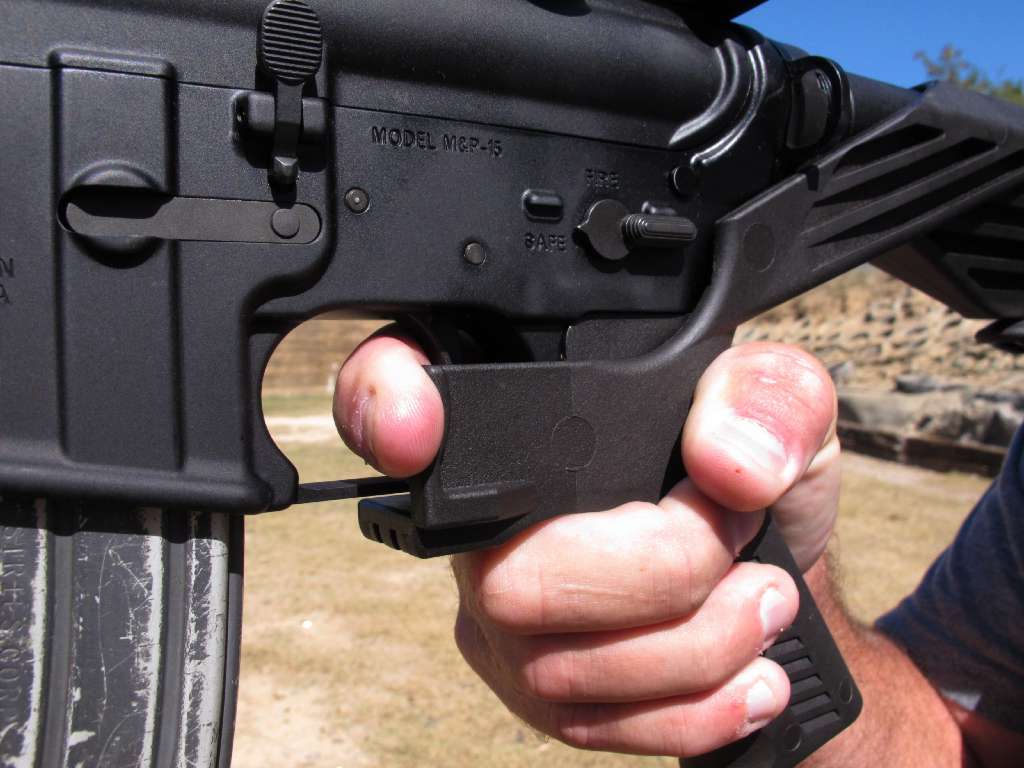Stand up for the facts!
Our only agenda is to publish the truth so you can be an informed participant in democracy.
We need your help.
I would like to contribute

Sens. Dianne Feinstein, D-Calif., and Richard Blumenthal, D-Conn., look at a rifle equipped with a bump stock during a press conference to announce a proposed ban on the devices at the Capitol in Washington on Oct. 4, 2017. (Getty Images photo)
Following the deadly massacre in Las Vegas, calls are growing to either ban or restrict the use of bump stocks, a device that can be attached to a semi-automatic rifle that allows it to mimic its fully automatic cousins.
Twelve of the rifles police found in Stephen Paddock’s Mandalay Bay hotel room were equipped with bump stocks. The increased rate of fire likely was a factor in the shooting, with 58 dead and 489 wounded.
Sen. Dianne Feinstein, D-Ca., first introduced a Senate bill on Oct. 4, 2017, proposing to ban the manufacture, sale and possession of the gun part. U.S. Reps. Carlos Curbelo, R-Fla., and Seth Moulton, D-Ma., also announced they were introducing a House bill that would do the same.
"This might be small, but I think a very important step towards moving to a more rational conversation about sensible gun policy in this country," Curbelo said.
Even the National Rifle Association, which routinely opposes measures that would set new restrictions on gun ownership, issued a statement that said the Bureau of Alcohol, Tobacco, Firearms and Explosives should "immediately review whether these devices comply with federal law."
Sign up for PolitiFact texts
President Donald Trump said "we'll be looking into" the proposed ban on bump stocks. Meanwhile, many members of Congress seemed unfamiliar with the devices.
"I didn’t even know what they were, until this week, and I’m an avid sportsman," House Speaker Paul Ryan said in an NBC interview.
So what is it?
A bump stock, sometimes called a "slide stock," modifies a semi-automatic rifle to fire faster and more easily than normal.
A bump stock or slide stock, shown here on an AR-15-style rifle, uses the recoil of a semiautomatic rifle to "bump" the trigger against the shooter's finger, allowing for a higher rate of fire without squeezing the trigger repeatedly. (AP photo)
In simplest terms, "semi-automatic" refers to any firearm designed to fire one bullet with one trigger squeeze, then automatically reload the chamber with a cartridge from a magazine and be ready to fire again. The shooter has to physically squeeze the trigger for the weapon to fire, limiting the rate a person can discharge ammunition.
A bump stock replaces a rifle’s regular stock, which is the butt end that the shooter uses to hold the rifle against his or her shoulder.
Normally a stock is fixed so it doesn’t move, and transfers the force of firing a cartridge into the shooter’s shoulder. This force is known as the recoil.
Instead of being fixed, a bump stock allows the firing mechanism and barrel of a rifle to slide back and forth with this recoil while the stock remains in place. The shooter’s grip doesn’t move, but the trigger will "bump" the shooter’s trigger finger after each cartridge is fired.
This makes the rifle fire over and over again without forcing the shooter to squeeze the trigger repeatedly, in effect simulating a rate of fire similar to an automatic rifle — what is often referred to as a machine gun.
Put another way, while a standard semi-automatic rifle requires someone to pull a trigger continuously, a bump stock allows the gun to do almost all of the work.
Automatic weapons allow a shooter to squeeze the trigger once to fire cartridges from a magazine repeatedly until the shooter releases it. Automatic weapons sales have been restricted in the United States since the 1934 National Firearms Act was passed.
Regulations put in place in 1986 made it much more difficult for civilian buyers to get an automatic weapon, although it is possible if a buyer pays for a $200 tax stamp and passes a background check. These guns are increasingly expensive, because the supply is limited to weapons manufactured before May 19, 1986.
Here’s a video from CBS showing bumps stocks on some semi-automatic rifles:
Bump stocks are not illegal, because the ATF judged they did not alter the actual mechanism of the firearm, and therefore did not violate federal law. The devices were approved for sale in 2010, and can cost about $100.
U.S. Rep. Steve Scalise, a Louisiana Republican who was shot in June at a GOP baseball practice, was another member of Congress who was unfamiliar with bump stocks before the Las Vegas massacre. He said he preferred the decision be left for the ATF to review, rather than quickly turn to legislation.
"I do think it’s a little bit early for people to say they know what to do to fix this problem," Scalise told Meet the Press host Chuck Todd.
There also are many similar devices that allow shooters to boost a semi-automatic gun’s rate of fire.
Trigger activators are essentially cranks or similar devices that fit into the trigger guard and depress the trigger repeatedly faster than a human could. There are also trigger assemblies that work in a similar fashion to bump stocks, or even a cumbersome glove that will activate a trigger over and over.
Feinstein’s bill addresses these devices in addition to bump stocks. The House bill was expected to also outlaw such accessories.
In the meantime, sales of bump stocks appear to have ticked up since the shooting.
Our Sources
Sources are linked in the story.



































